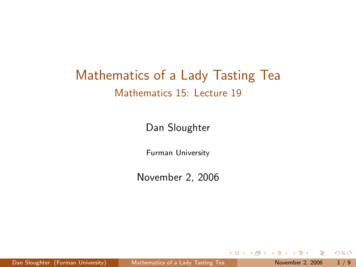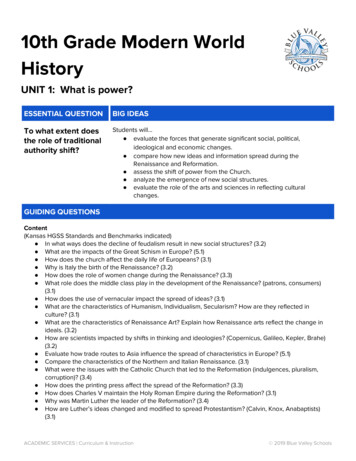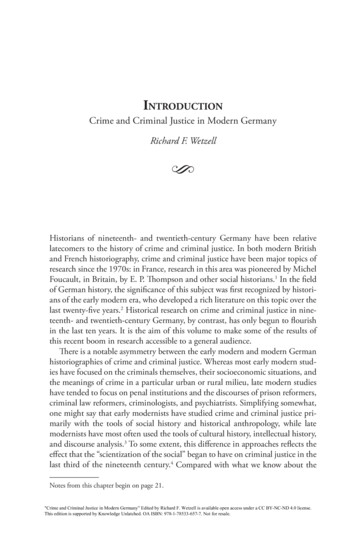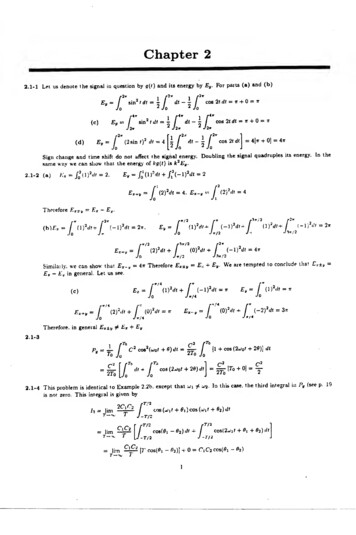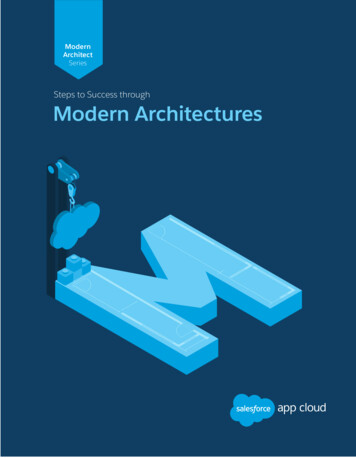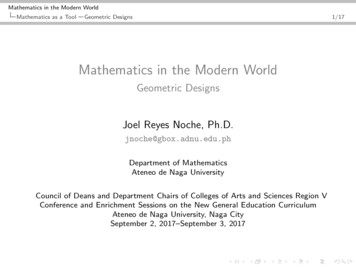
Transcription
Mathematics in the Modern WorldMathematics as a ToolGeometric Designs1/17Mathematics in the Modern WorldGeometric DesignsJoel Reyes Noche, Ph.D.jnoche@gbox.adnu.edu.phDepartment of MathematicsAteneo de Naga UniversityCouncil of Deans and Department Chairs of Colleges of Arts and Sciences Region VConference and Enrichment Sessions on the New General Education CurriculumAteneo de Naga University, Naga CitySeptember 2, 2017–September 3, 2017
Mathematics in the Modern WorldMathematics as a ToolGeometric DesignsGeometric DesignsGeometry can help enhance ones artistic prowess as well as enrich ones own culture.Learning outcomesIApply geometric concepts, especially isometries in describingand creating designs.IContribute to the enrichment of the Filipino culture and artsusing concepts in geometry.2/17
Mathematics in the Modern WorldMathematics as a ToolGeometric DesignsFractals(Aufmann, Lockwood, Nation, & Clegg, 2013, §7.7)A fractal is a geometric figure in which a self-similarmotif repeats itself on an ever-diminishing scale.Fractals are generally constructed by using iterativeprocesses in which the fractal is more closelyapproximated as a repeated cycle of procedures isperformed.3/17
Mathematics in the Modern WorldMathematics as a ToolGeometric DesignsNo. 5, 1948 by Jackson Pollock(Vogel, 2006)4/17
Mathematics in the Modern WorldMathematics as a ToolGeometric Designs4/17No. 5, 1948 by Jackson Pollock(Vogel, 2006)In 2006, this painting was reportedly sold for about 140million, the highest sum everknown at that time to havebeen paid for a painting.
Mathematics in the Modern WorldMathematics as a ToolGeometric Designs5/17Fractal analysis of Pollock’s drip paintings(Taylor, Micolich, & Jonas, 1999; Taylor, 2002)Scientific objectivity proves to be an essentialtool for determining the fundamental contentof the abstract paintings produced by JacksonPollock in the late 1940s. Pollock dripped paintfrom a can onto vast canvases rolled out acrossthe floor of his barn. Although this unorthodoxtechnique has been recognized as a crucial advancement in the evolution of modern art, theprecise quality and significance of the patternscreated are controversial. Here we describean analysis of Pollock’s patterns which shows,first, that they are fractal, reflecting the fingerprint of nature, and, second, that the fractaldimensions increased during Pollock’s career.
Mathematics in the Modern WorldMathematics as a ToolGeometric DesignsFractals are self-similar(Taylor, 2002)6/17
Mathematics in the Modern WorldMathematics as a ToolGeometric Designs7/17The fractal character of Pollock’s paintings(Taylor, 2002)The painting is scanned into acomputer. It is separated intoits different colored patterns,then covered with a computergenerated mesh of identicalsquares. The computer analyzeswhich squares are occupied andwhich are empty. This is donefor different mesh sizes. Thepatterns were found to be fractal over the entire size range.
Mathematics in the Modern WorldMathematics as a ToolGeometric DesignsStudying the paintings chronologically showedthat the complexity of the fractal patterns, D,increased as Pollock refined his technique.One D value is clearly an outlier—1.9 in 1950,a work that Pollock later destroyed. He mayhave thought this image was too dense or toocomplex and subsequently scaled back.8/17
Mathematics in the Modern WorldMathematics as a ToolGeometric Designs9/17Mathematical and anthropological analysis of northern Luzon funeral textile(De Las Peñas & Salvador-Amores, 2016, p. 91)An isometry is a geometric transformation that keeps the distancebetween points unchanged. (A symmetry is an isometry whichsends a pattern to itself.)(a)(b)(c)(d)
Mathematics in the Modern WorldMathematics as a ToolGeometric DesignsMathematical and anthropological analysis of northern Luzon funeral textile(continuation) (De Las Peñas & Salvador-Amores, 2016, p. 91)There are exactly four types of isometries in the plane:(a) A translation moves every point of the plane through a fixeddistance in a particular direction specified by a given vector(b) A reflection moves every point of the plane to its mirror imageabout a fixed line called an axis of reflection(c) A rotation moves every point of the plane through a fixedangle about a fixed point called the center of rotation(d) A glide reflection is a combination of a translation and areflection, defined by specifying a reflection axis and atranslation vector parallel to the axis of reflection10/17
Mathematics in the Modern WorldMathematics as a ToolGeometric DesignsMathematical and anthropological analysis of northern Luzon funeral textile(continuation) (De Las Peñas & Salvador-Amores, 2016, pp. 91–92)There are three (non-trivial) classes of symmetrical patterns thatmay be found in textile:1. A finite pattern is a repeated pattern that does not admit anytranslational symmetries. It admits either only rotationalsymmetries or both rotational and reflectional symmetries2. A frieze pattern is a symmetric pattern along a strip that hastranslational symmetries in one direction3. A plane crystallographic pattern is a repeated pattern that hastranslational symmetries in two directions11/17
Mathematics in the Modern WorldMathematics as a ToolGeometric DesignsMathematical and anthropological analysis of northern Luzon funeral textile(continuation) (De Las Peñas & Salvador-Amores, 2016, pp. 92)The set consisting of all symmetries of a finite pattern,frieze pattern or a plane crystallographic pattern form analgebraic structure called a group under the operationcomposition of isometries. This is called the symmetrygroup of the respective pattern. There are seven types offrieze patterns and seventeen types of planecrystallographic patters known; each is classified based onits symmetry group or the symmetries the pattern admits.12/17
Mathematics in the Modern WorldMathematics as a ToolGeometric DesignsMathematical and anthropological analysis of northern Luzon funeral textile(continuation) (De Las Peñas & Salvador-Amores, 2016, Table 1)13/17
Mathematics in the Modern WorldMathematics as a ToolGeometric DesignsYakan textile weaving designs(Haute Culture, 2016)14/17
Mathematics in the Modern WorldMathematics as a ToolGeometric DesignsYakan textile weaving designs (continuation)(Haute Culture, 2016)15/17
Mathematics in the Modern WorldMathematics as a ToolGeometric DesignsSample exam questionDissect the rep-tiles below into four smaller (same-sized) copies ofthemselves.16/17
Mathematics in the Modern WorldReferencesAufmann, R. N., Lockwood, J. S., Nation, R. D., & Clegg, D. K. (2013).Mathematical excursions (3rd ed.). Belmont, CA: Brooks/Cole,Cengage Learning.De Las Peñas, M. L. A. N., & Salvador-Amores, A. V. (2016). Mathematicaland anthropological analysis of northern Luzon funeral textile.Philippine Journal of Science, 145, 89–103.Haute Culture. (2016, March 2). Textile tribes of the philippines: Yakanweaving, weddings and wears. Retrieved May 3, 2017, tiles-mindinao-philippines/Taylor, R. P. (2002). Order in Pollock’s chaos. Scientific American, 287(6),116–121.Taylor, R. P., Micolich, A. P., & Jonas, D. (1999). Fractal analysis of Pollock’sdrip paintings. Nature, 399, 422.Vogel, C. (2006, November 2). A Pollock is sold, possibly for a record price.The New York Times. Retrieved July 29, 2012, 02drip.html? r 1&adxnnl 1&ref arts&adxnnlx 1163031599-revbGMuaIhdTP4qLonq8BA&oref slogin17/17
(Aufmann, Lockwood, Nation, & Clegg, 2013, x7.7) A fractal is a geometric gure in which a self-similar motif repeats itself on an ever-diminishing scale. Fractals are generally constructed by using iterative processes in which the fractal is more closely approximated as a repeated cycle of procedures is

